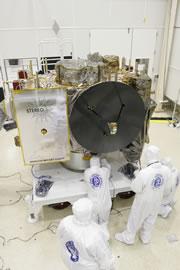 NASA's spacecraft are clean, but not sterile.NASA
NASA's spacecraft are clean, but not sterile.NASAThe ultra-clean facilities used to assemble NASA's spacecraft are inhabited by some hardy bacteria, which could be hitchhiking their way to space.
Samples from NASA's Jet Propulsion Laboratory (JPL), Kennedy Space Center and Johnson Space Center, show the variety of bacteria that make it into the spaceship assembly areas despite the clean rooms used to build the craft in. The team found an eclectic selection of bacteria, including some that thrive in harsh environments with no food, at high temperatures or pH, or in high levels of chlorine.
Researchers will use the list of found bacteria to compare against any specimens brought back on future space missions. This will help researchers to determine whether any bacteria they encounter really have an extraterrestrial origin, or simply hitchhiked out to space and back from Earth. "We now understand a little better what type of [Earthly] organisms we're dealing with," says Catharine Conley, NASA's planetary protection officer.
Spacecraft are put together in clean rooms that are subject to stringent national and international regulations. The Outer Space Treaty of 1967 was the first to put limits on what humans should, or should not, release into space. These precautions exist to protect extraterrestrial environments from being contaminated, and also to help ensure that any future detections of extraterrestrial life are not false positives.
NASA has its own specific set of rules, which specifies what kind of filters are needed on clean-room air vents, and what kind of protective outfits any people entering the rooms must wear. Spacecraft materials are cleaned with harsh chemical cleansers and bathed in ultraviolet light, and are routinely swabbed to check for bacteria as craft are being built. For Mars landings similar to the Viking mission of 1975, NASA's limits are set to prevent any more than 300 spores landing on a square metre of martian surface.
Not sterile
The fact that some bacteria do survive in NASA clean rooms is not surprising. "The rooms are not sterile," says Michel Viso, an astrobiologist at the French space agency CNES in Paris. What was interesting was to catalogue the diversity of the hardy bacteria, he adds.
Kasthuri Venkateswaran, at the JPL facility at the California Institute of Technology, Pasadena, and his colleagues looked at the genetic and molecular make-up of any bacteria found alive in the three sites.
Each site that was sampled contained very different communities, they found, and some of the bacteria strains included members of the spore-forming Bacillus family that had never been seen before. They also found some extremophile bacteria — those that thrive in extreme conditions. These included Methylobacterium, which is known to be resistant to high levels of chlorine, and bacteria that usually grow at temperatures of about 60 ºC.
The clean rooms aren't necessarily hot, but do have extremely limited nutrients and have other harsh conditions. "It is, by nature, an extreme environment; it's not surprising that extremophiles exist there," says John Rummel, senior scientist for astrobiology at NASA headquarters, Washington DC, of the clean rooms.
Killer light
So should we be worried about these hardy critters ending up on Mars? It is unlikely that they would be tough enough to survive there, says Rummel: "UV radiation kills everything over a period of time anyway."
NASA imposes stricter rules for any craft that might come in contact with liquid water on Mars, and this conservative policy seems to have so far been successful, says Rummel. "Nothing we've sent to Mars would suggest a runaway growth."
ADVERTISEMENT
Contamination is a real concern, says Conley, but she is less worried about contaminating Mars than dirtying Jupiter's moon Europa, in any future missions. Europa has subsurface liquid water sitting over rock and lava — exactly like a hydrothermal vent on Earth where bacterial communities are known to thrive, she says. One need only look to our own planet to prove that we are capable of causing damage: "If we contaminate places on Earth, it screws things up," she says, and also supports a conservative approach to cleanliness. "Why take the chance?" she adds.
Cleaner clean rooms than the ones used by NASA do exist — for example in microprocessor manufacture, or the pharmaceutical industry. But the costs of these facilities are prohibitive when the clean room is only used once every two years, says Conley.
Visit our cleanroomsbreedhardy_b.html">newsblog to read and post comments about this story.
